COVID19, sinking incomes and rising LPG prices force rural women into using polluting fuels. Will Ujjwala 2.0 improve matters?
When the first phase of Ujjwala scheme was launched five years ago, it brought hope to millions of rural women who cook with dirty fuels. They received LPG cylinders, however several of them are back to cooking with firewood and cow dung cakes. Gaon Connection travelled to villages in Uttar Pradesh, Madhya Pradesh and Bihar to speak to women — the scheme’s official beneficiaries. A ground report.

Five days prior to India’s 75th independence day, Prime Minister Narendra Modi, in a virtual ceremony on August 10, launched the second phase of the Pradhan Mantri Ujjwala Yojana (PMUY) being widely marketed as Ujjwala 2.0. In the virtual event, PM Modi handed over liquefied petroleum gas (LPG) cylinders to 10 women in the Mahoba district of Uttar Pradesh and stated that his government’s aim is to ensure that the benefit of the country’s resources reach all citizens. The scheme’s first phase was launched in May 2016.
At a distance of about 270 kilometres from the ceremony in Mahoba where women received free of cost LPG cylinders along with a hotplate, 35-year-old Reshma of Belhara village in Barabanki cooked rice for her kids. Sitting on haunches, her eyes watering, she bent over the chullah to feed it some polythene bags. An LPG cylinder, which she had received under the Ujjawala scheme in 2019, adorned a dingy corner of her kitchen. It was empty for months, she said.
“Bahut pareshaan hai bhaiya, poora mahina abki kaam nahin laga. Udhaar le k kaam chala rahe. Ab gas dekhen, apna paet dekhen, ya araam dekhen. Paisa hi nahi hai cylinder bharane ka,” Reshma, whose husband works as a labourer, told Gaon Connection. (I am in distress, this entire month there has been no work for my husband. We are somehow managing to eat by arranging for loans. There’s no money to refill the cylinder)
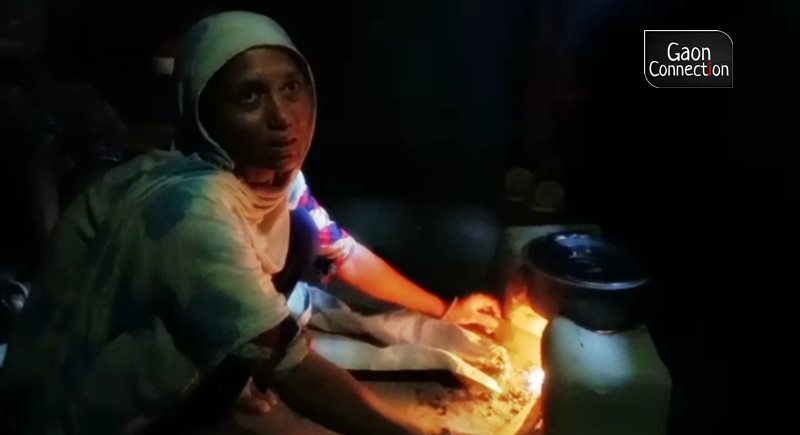
Unaware of the health risks involved in burning plastic and inhaling its toxic smoke, Reshma informed that for the past five months whenever she ran out of money to buy a kilo of firewood, which costs Rs 10-Rs 20, she has been collecting some waste polythene bags from her village in Barabanki district of Uttar Pradesh to burn them to cook food.
An LPG cylinder refill weighing 14.2 kilograms costs Rs 897.50 in Lucknow as on August 29.
Also Read: “Do we refill the cylinders or feed ourselves?”
In May 2016, Ministry of Petroleum and Natural Gas introduced the ‘Pradhan Mantri Ujjwala Yojana’ as a flagship scheme with an objective to make clean cooking fuel such as LPG available to the rural and deprived households (below poverty line) which were otherwise using traditional cooking fuels such as firewood, coal, cow-dung cakes etc. Usage of traditional cooking fuels is linked to indoor air pollution and has detrimental impacts on the health of rural women as well as on the environment.
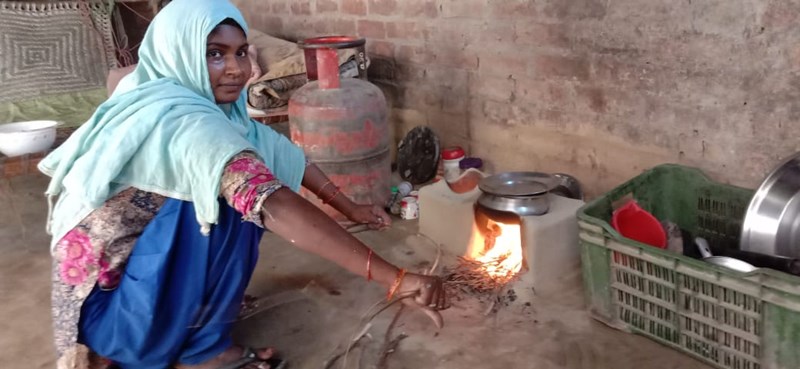
The scheme was launched on May 1, 2016 in Ballia, Uttar Pradesh by Modi. According to the ministry of petroleum, so far free of cost gas cylinders have been alloted to 80,699,686 households across India. Under Ujjwala 2.0, 10 million new LPG connections are being given with the first refill of the cylinder free of cost.
However, a number of independent studies point out how several women in rural India, who have received free cylinders under the scheme, continue to depend on traditional, polluting cooking fuels. The COVID19 pandemic and the resultant loss of livelihood in rural India has had a direct bearing on the women’s access to clean cooking fuel.
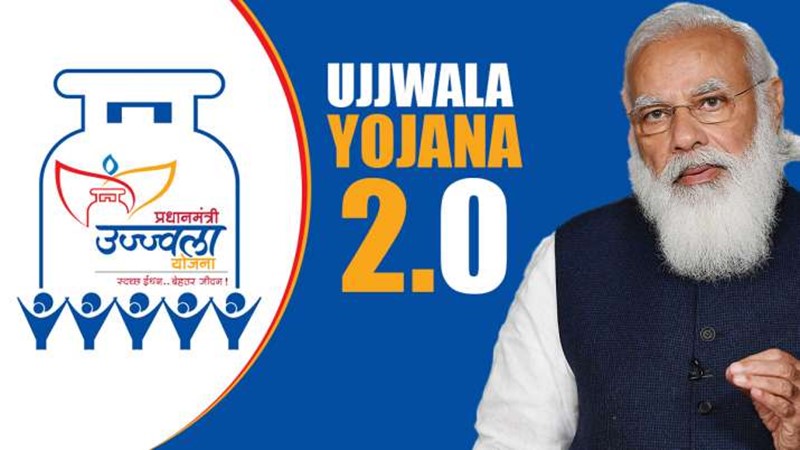
COVID19, lockdowns and loss of livelihood
Sixty-year-old Vimla Dohar, a widow from Chhoti Lalpur village in Madhya Pradesh’s Satna district, told Gaon Connection that she had not got her cylinder refilled since the Raksha Bandhan festival last year (August 3, 2020). The district has a total of 226,000 households assigned the LPG cylinders under the Ujjwala scheme, including Dohar.
Also Read: Despite having LPG cylinders, rural women are back cooking on woodfired stoves
“My husband is no more. My sons are also not able to find any work as there is little demand for labourers these days. There’s no source of income, it is crazy to think about getting the cylinder filled,” she said while blowing air into the chullah to fasten the burning of firewood. Refilling an LPG cylinder in Satna costs Rs 885.50.
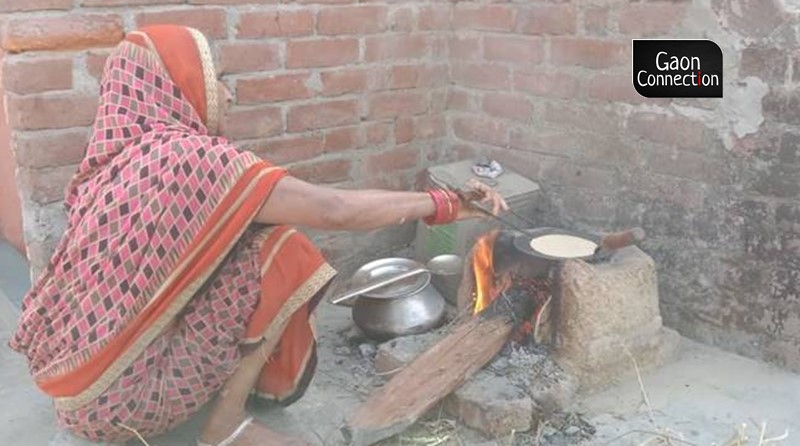
In the neighbouring state of Chhattisgarh, Lalita Baghel, a resident of Sankra village in Patan district, told Gaon Connection that it is only once in three-four months that she can afford to get her cylinder refilled.
“My husband and son are daily wage labourers. Our earnings are just enough for us to barely fill our stomach with some food. The prices for LPG are way too high. We only use it if some guests visit our house and tea or snacks have to be prepared quickly. Rest of the time, I use firewood,” she told Gaon Connection.
Her neighbour, Momin Bai told Gaon Connection that it takes months for her to raise the money for refilling the cylinder which is why she prefers to cook on firewood.
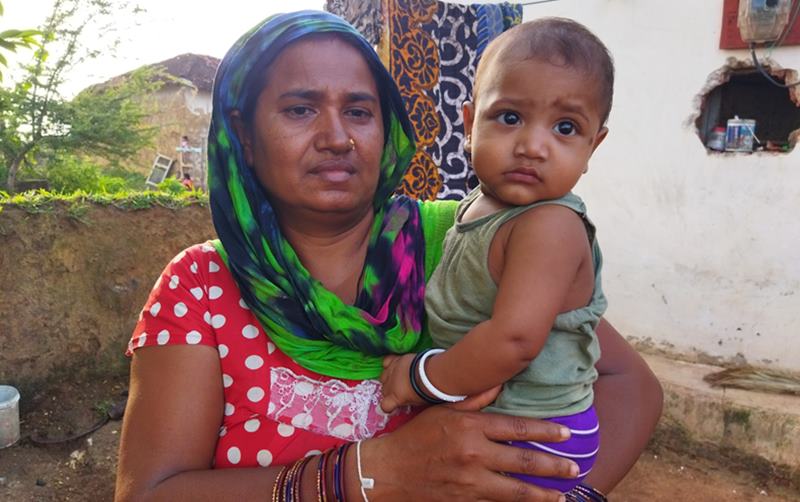
“Either our incomes should increase somehow or the government must bear the cost of refill if it really wants us to continue using it,” she said.
Somewhat similar is the story of Reshma, the 35-year-old resident of Belhara village in Barabanki, who has 10 members in her family. “Due to the mahamari [pandemic] and the Corona lockdown that was declared in March, last year, our source of income has shrunk. My husband has great difficulty finding work as a construction labourer. I haven’t been able to refill my cylinder for the last five months as there’s no money.,” she said.
Also Read: Five fisherwomen in Tamil Nadu set up Dolphin, a restaurant, and free their husbands of debt
“Kahin paisa kamane ka zariya hi nahin hai, kisi tarah guzaara ho raha bas,” Reshma said. (There’s no source of livelihood, we are barely surviving somehow)
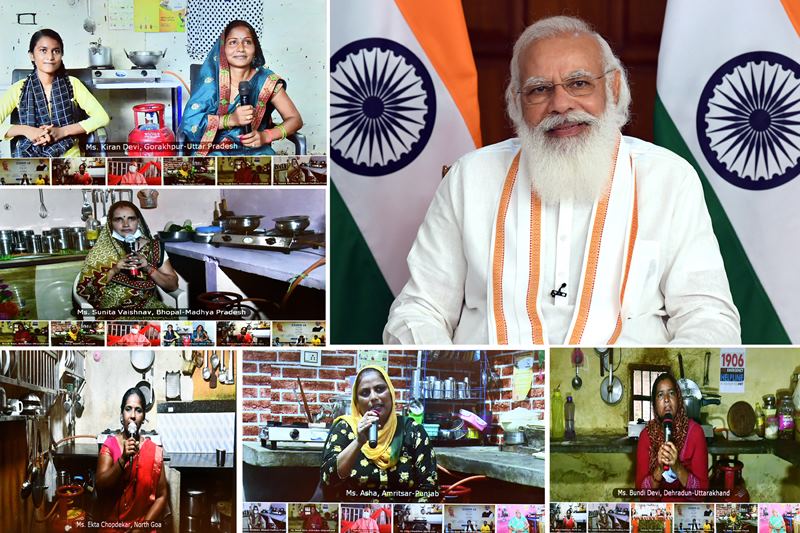
“We are back to using wood to cook food as we haven’t been able to get our cylinder filled after the lockdown was announced. The women in our families trek at least four kilometres everyday to get the wood,” Manoj Singh, a 35-year-old farmer in the Fata village of Uttarakhand’s Rudraprayag district, told Gaon Connection. “It’s a laborious task to collect firewood. The women are suffering because of it. It is risky to carry heavy quantities of wood in the hills so the women have to go out everyday to get small bundles of firewood,” Singh said.
Meanwhile, there are a large number of poor rural women who are yet to receive any benefit of the Ujjwala scheme. Supaul district’s Rahi Tola village in Simra panchayat area is home to about a 100 poor families who use firewood to cook food. Middle-aged Gita Devi told Gaon Connection that she collects firewood from a nearby orchard.
“Uske liye gaali bhi sunna padta hai,” she said. (I am subjected to verbal abuse by the orchard owner as he doesn’t like me entering his orchard)
Unlike her, Sunita Devi, a mother of three who lives in the nearby Narayanpur village has received the cylinder under the Ujjwala scheme but hasn’t been able to get it refilled.
“My husband works as a labourer in Dilli (Delhi). He is unable to send as much money back home as it takes to get the cylinder refilled. Cooking on choolha is far cheaper,” she said.
Also Read: Rural women in Uttar Pradesh spin a banana yarn and earn themselves economic independence
Dulari Devi, who’s a teacher in the same village informed Gaon Connection that almost ‘85 per cent’ of the beneficiaries of the scheme in the village are not able to refill the cylinders and have switched back to firewood.
Soaring cost of LPG cylinder
India’s energy use has doubled since 2000, with 80 per cent of demand still fulfilled by coal, oil, and solid biomass. “With about 65 per cent of Indian households being highly energy-deprived, energy poverty is an issue that demands immediate attention to deal with its associated socio-economic problems,” reads a recent column published in Gaon Connection. The authors on on to note that “There lies a vast gap between rural and urban energy consumption as well… substantial rural population lacks adequate electric power supply and clean energy fuel in India, resulting in dependence upon unsustainable energy sources that affect both the health and the environment.”

Ujjwala scheme is meant to bridge this urban-rural gap and address energy poverty in the country.
However, a large number of rural women, who are Ujjwala beneficiaries, have gone back to cooking on firewood and cow dung cakes, as the rural economy has faced the brunt of the pandemic. Meanwhile, the cost of the LPG refill cylinder has jumped from Rs 527 in May 2016, when the scheme was launched, to now Rs 859 (both prices for New Delhi) when Ujjwala 2.0 has been kicked off. In the past nine months alone, the prices of LPG refills have risen by almost 140 per cent in the last nine months.
In Uttar Pradesh capital, the price of a domestic LPG cylinder refilling was Rs 632 in November, 2020 and it has now soared to Rs 897 in the latest round of price revision on August 18, which the government attributes to higher crude oil prices in the international markets.
In Bhramarpur village in the Bhagalpur district of Bihar, an LPG agency official told Gaon Connection on the condition of anonymity that hardly any beneficiary of the scheme in the village is able to refill the cylinder.
Dealers of the LPG gas connection too blame the rise in cylinder price for the inability of rural households to refill the cylinder. “Earlier when the prices of LPG cylinder refilling were not too high last year, around 24 per cent of the cylinders used to get refilled, but now the percentage has come down to 16 per cent,” Sumit Kumar Sonkar, the field officer of Indane Gas service in Barabanki, Uttar Pradesh, told Gaon Connection. He informed that the district had 700,000 LPG gas connections of which 225,000 were allotted under Ujjwala scheme.
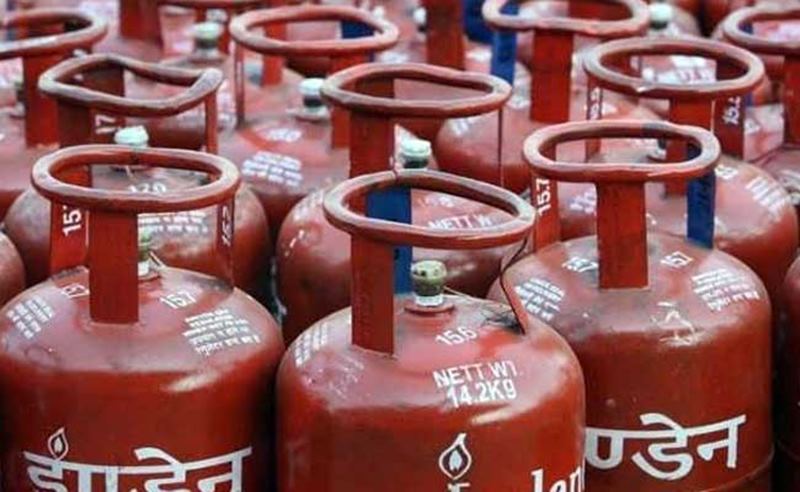
But some districts in Uttar Pradesh are faring well with the scheme. Hina Uttam, the LPG sales manager of the Sitapur district, told Gaon Connection that the district has recorded a refiling rate of 98 per cent amongst the beneficiaries of the Ujjwala scheme since May 1, 2o16. There are 500,700 beneficiaries of the scheme in the district, he added.
As per the August 25 press statement by the Uttar Pradesh government, at least two million women in the state are benefitting from the scheme. “Before 2014 (when BJP formed the government at the Centre) long queues of people lining up to get their cylinders refilled were a common sight across the country. We have rescued the mothers and sisters of this country from the environment of toxic smoke they were forced to cook in,” Chief Minister Yogi Adityanath was quoted in the press release.
Roadblocks in Ujjwala
A number of independent research studies have analysed the pros and problems of the Ujjwala scheme. A November 2018 study titled ‘Access to Clean Cooking Energy and Electricity – Survey of States’, which was conducted by New Delhi-based Council on Energy, Environment and Water (CEEW), stated:
“While PMUY attempted to increase the agency of women by providing connections in the name of the female lead of the household, the study found that only in a third of LPG households women participated in decision-making regarding LPG refills. Understanding and attending to intra-household decision making and associated gender dynamics would be critical to ensure sustained use of LPG among rural households.”
Another recent May 2020 study, ‘Women Empowerment through Pradhan Mantri Ujjwala Yojana (PMUY) Scheme in Rajasthan: A Study on Rural Households in Selected Region’, conducted by the department of business administration in the University of Rajasthan, concluded that inconvenience in refilling the cylinders, lack of accessibility and absence of awareness about the probable benefits of LPG and the disadvantage of other cooking fuels might have restricted the continuous use of this cleaner energy.
“Moreover, a large number of socio-economic issues at the domestic level faced by women and institutional frameworks also impact the effectiveness of PMUY,” the Rajasthan university study noted.
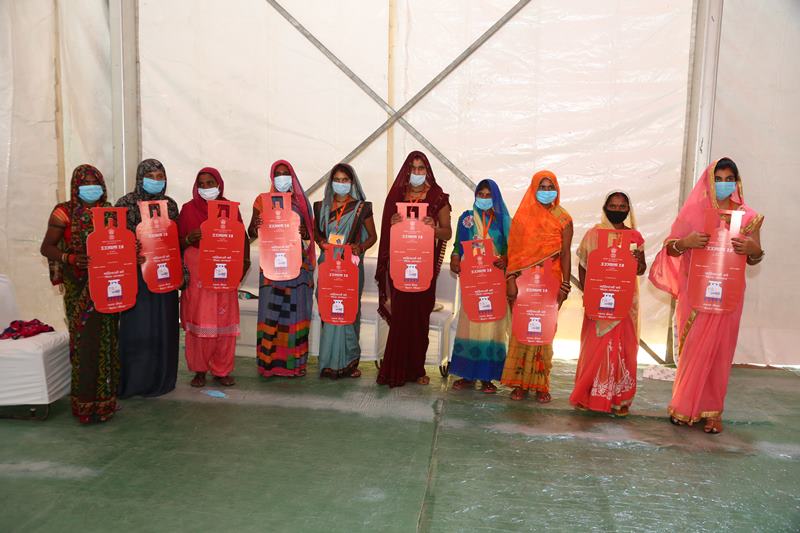
In its audit report on the scheme on December 11, 2019, the Comptroller and Auditor General of India (CAG) observed that a total of 7.2 crore (72 million) connections have been issued under the scheme against a target of eight crore by March 2020 (90 per cent completion). Further, it also found that the LPG coverage in the country has increased from 62 per cent in May 2016 to 94 per cent in March 2019.
However, the CAG report observed that the average annual refill consumption for PMUY beneficiaries has remained low, compared to non-PMUY consumers which points towards a lack of sustained usage of LPG by the beneficiaries under the scheme.
Additionally, another article, ‘Using sales data to assess cooking gas adoption and the impact of India’s Ujjwala programme in rural Karnataka’, published in Nature Energy journal on July 15, 2019, deduced that the number of LPG refills among PMUY beneficiaries is less than half that of rural general consumers.
Also Read: For many women artisans, traditional embroidery is a passport to self-empowerment
“We find rapid growth in enrolments of LPG consumers, but this is not matched by an increase in LPG sales, suggesting that LPG access has not induced a full transition away from the use of polluting solid fuels,” the study from rural Karnataka stated. The researchers suggested mid-course policy revisions to encourage regular LPG use.
It was also found that there’s a lack of awareness about the scheme amongst many villagers. In Bihar’s Rahi Tola village in Supaul district, 70-year old Ajita Devi told Gaon Connection that she has never heard of the ‘Ujjwala’.
“I have never heard of this scheme. I neither know how to cook on a gas stove nor have I been told by anybody to get a cylinder. I use firewood for cooking,” she said.
Rural women choking over kitchen smoke
According to the World Health Organization (WHO), each year, worldwide close to four million people die prematurely from illness attributable to household air pollution from inefficient cooking practices using polluting stoves along with solid fuels and kerosene.
“Small particulate matter and other pollutants in indoor smoke inflame the airways and lungs, impairing immune response and reducing the oxygen-carrying capacity of the blood. There is also evidence of links between household air pollution and low birth weight, tuberculosis, cataract, nasopharyngeal and laryngeal cancers,” WHO said in its fact sheet published on May 8, 2018.
Pratima Devi, a resident of Durjan Kheda village in the Sadar tehsil of Unnao district in Uttar Pradesh, is post-graduate by qualification. She understands the health costs of cooking on firewood and cow dung cakes. But she had little choice, she told Gaon Connection.
“Getting the cylinder filled every month is difficult so I cook on a chullah (mud stove that uses firewood). I use a cylinder when I have to cook urgently or if guests arrive,” said Pratima Devi. “But cooking on the chullah is not easy. I feel intense irritation in my eyes and tears roll down my eyes as a lot of smoke comes out of the burning firewood. The utensils get very dirty due to smoke and it takes a lot of effort to wash them clean,” the 28-year-old said.
Her condition is similar to that of Gulab Devi, a middle-aged tribal resident of Patehra village in Marihan tehsil of Mirzapur. She has not received an LPG cylinder yet.
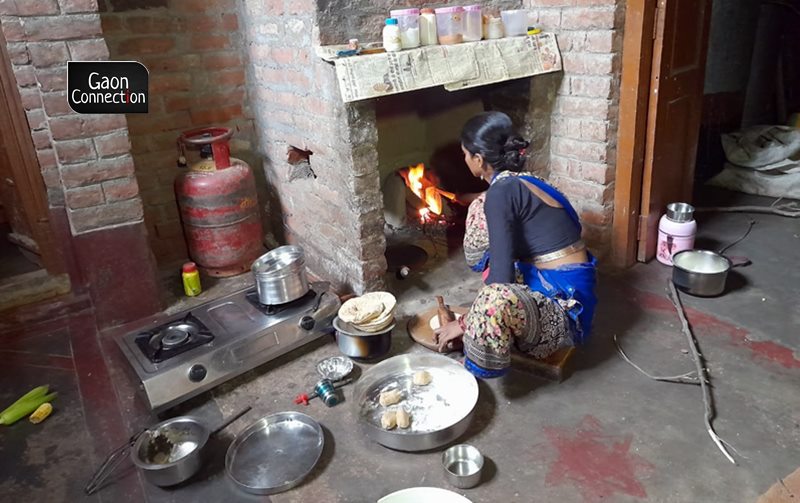
“I face frequent headaches and chest pain due to cooking on the firewood. My eyes itch throughout the day and bringing the wood from the forest is a hefty task. I cough a lot and my stomach hurts sometimes,” the tribal woman narrated to Gaon Connection.
Ujjwala scheme has great potential to brighten up the dark and dangerous lives of rural women who are forced to suffer the ill-effects of polluting sources of cooking fuels. Providing affordable and reliable energy to each household in the nation is vital to social security and environmental conservation, and economic equity.
Written by Pratyaksh Srivastava. With inputs from Virendra Singh in Barabanki (Uttar Pradesh), Sumit Yadav in Unnao (UP), Mohit Shukla in Sitapur (UP), Brijendra Dubey in Mirzapur (UP), Sachin Tulsa Tripathi in Satna (MP), Praphull Thakur in Durg (Chhattisgarh), and Rahul Kumar in Supaul (Bihar).

